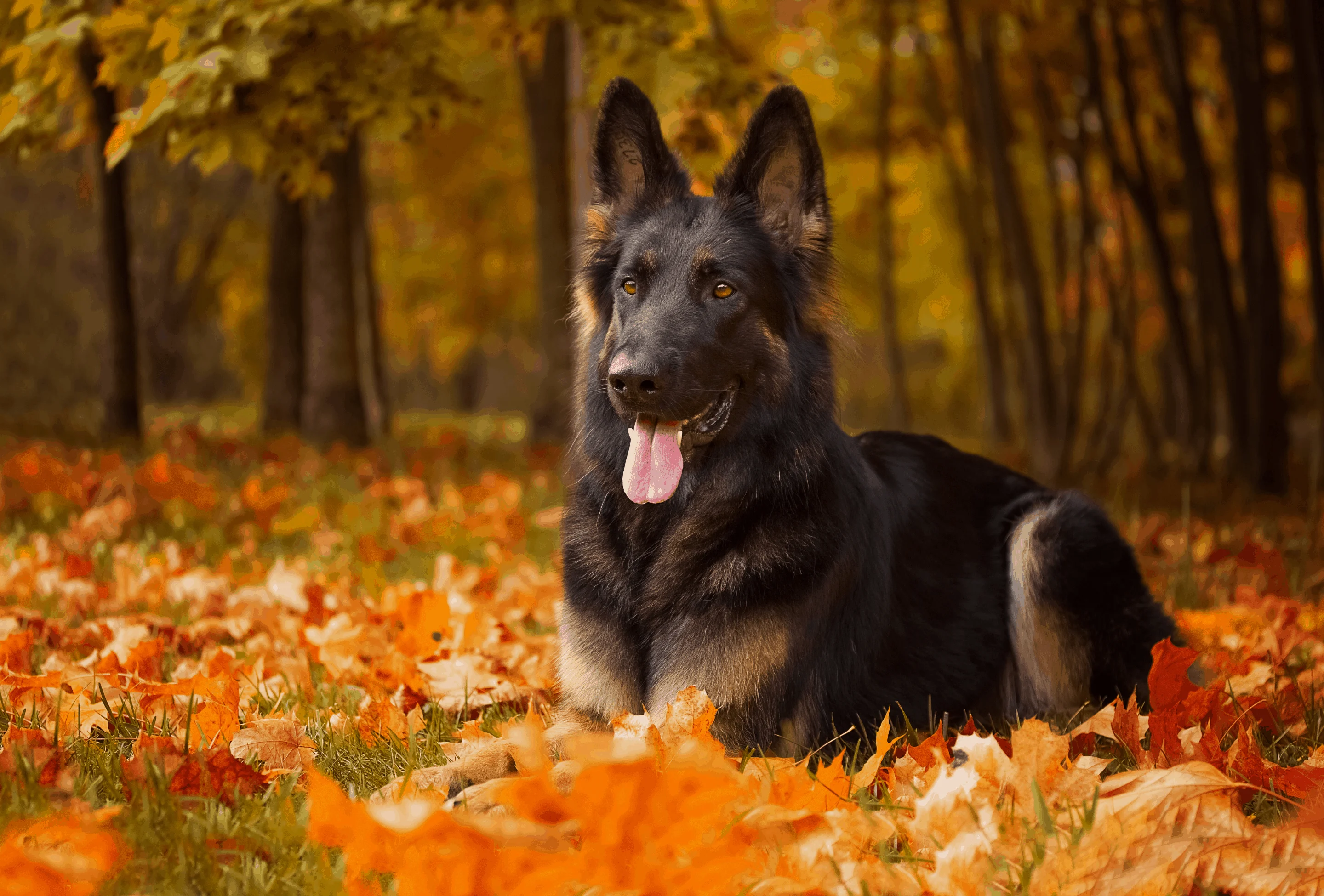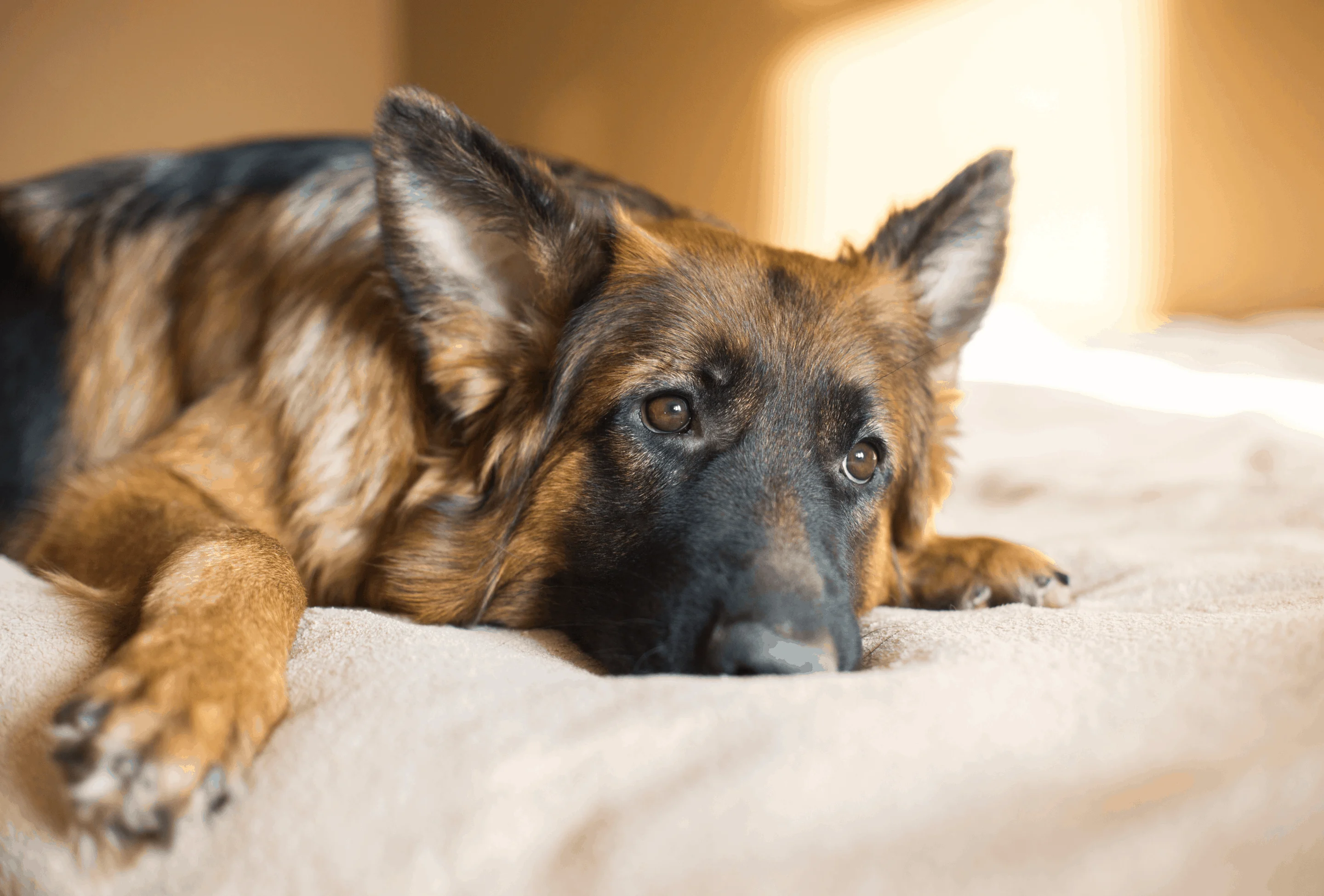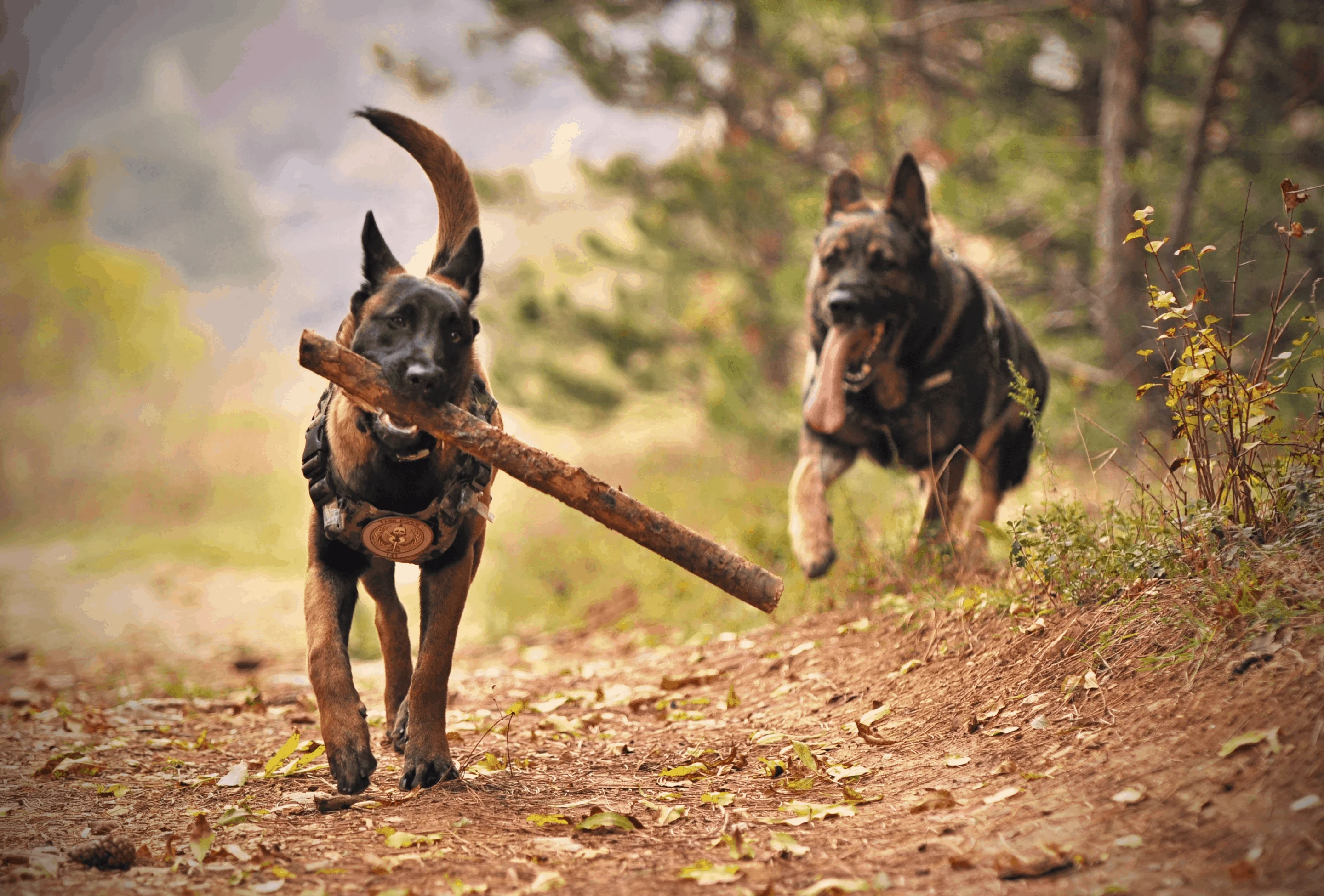German Shepherds are amazing working dogs that have been bred and utilized since the late 19th century.
These versatile and agile companions require a lot of devotion and care when it comes to exercise and health needs.
As owners, our goal is to be able to live as long as possible with our dogs and make their comparatively short life most enjoyable.
To help you achieve that, we have compiled everything you need to know about breed-related health issues and what you can do to increase your German Shepherd’s lifespan.
German Shepherd Lifespan
German Shepherds have a life expectancy of about 7-13 years which is a bit shorter than the average lifespan of 10-13 years for all dogs.
How long they will actually live depends on many factors like breeding, health, exercise, care, upbringing, and the environment.
A large determining factor is breed-related health issues. German Shepherds can suffer from many life-shortening and threatening diseases that can abruptly cut into their lives.
Luckily there are many things you can do to better and even prolong your dog’s longevity which we will talk about more below.

Why Do German Shepherds Have a Short Lifespan?
In general, small breeds tend to live significantly longer than large breeds. As an example: a Chihuahua may become 20 years old while a Great Dane would die more than 10 years earlier.
Paradoxically, large animal species tend to live longer than small species. An elephant can easily live to be 80 years old while mice only have 2 short years.
So why does this rule change within the same species? Researches actually don’t know 100%.
But a huge study with over 80,000 dogs has found that small and large dog breeds are differentially susceptible to certain diseases with large dogs being more prone to musculoskeletal diseases (like German Shepherds).
The lifespan of a dog also seems to drastically decrease when body mass increases, especially in giant breeds like the aforementioned Great Dane.
We will talk more about breed-related health issues of the German Shepherd below, but there is one problem that drastically shortens their lifespan: joint issues.
You may have noticed that I have given you a fairly large lifespan estimation above. The AKC states the longevity from 7-10 years while other sites lean more to 10-13 years.
This discrepancy may be due to the different breeding styles of the show lines and working lines.
The AKC breed standard defines their back’s appearance as follows “The withers are higher than and sloping into the level back. The back is straight, very strongly developed without sag or roach, and relatively short.”
Modern show lines lean more towards a sloped and long back that makes them more prone to hip dysplasia and arthritis.
The KC is concerned about the soundness in the show strains and a documentary called “Pedigree Dogs Exposed” really promoted this dispute.
Their position statement is the following:
The Kennel Club remains in no doubt that currently, the single biggest threat to the reputation and interest of the breed is the lack of soundness in hindquarters.
This issue of soundness is not a simple difference of opinion, it is the fundamental issue of the breed’s essential conformation and movement.
The Kennel Club
I have created a whole article on the difference between the sloped and straight back German Shepherd that thoroughly explains how it affects their mobility and how different conformations affect their posture and movement.
Leading Causes of Death in German Shepherds
Leading causes of death in dogs mainly vary by age and breed. While most young dogs die from trauma (car accidents, falls, dog fights) or infectious diseases, about 50% of all dogs over the age of 10 years die from cancer.
A huge Swedish study with over 400,000 German Shepherds analyzed insurance data for morbidity and mortality rates.
They came to the conclusion that GSDs most commonly died from locomotor disorders like hip dysplasia or myelopathy.
This would confirm the results from the aforementioned study that large dogs are more prone to musculoskeletal diseases.
They also found that German Shepherds were strikingly overrepresented for immunological diseases.
German Shepherd Health Issues
Like every breed, GSDs can be affected by a variety of health issues that are frequently seen and spread within the breed. Inbreeding and line breeding greatly promote the inheritance of recessive diseases.
You have probably heard of inbreeding before where close relatives are being bred together to produce offspring.
Diseases that would normally be recessive are now transmitted from both parents and as the gene pool becomes smaller and smaller the risk for inherited health issues becomes significantly larger.
Linebreeding is a bit more complicated. Assuming you have two dogs that are siblings (both male) and you take one of them and pair him with a dam that is not related to the bloodline.
You would get an x amount of puppies. Now you take one of those puppies (a female in this case) and breed her with her father’s brother. In conclusion, this example would be for the breeding of an uncle to his niece.
This is called line breeding as you are breeding back in line to the original sire. As a form of inbreeding, it still has a high risk of genetic defects.

Hip Dysplasia
Hip dysplasia is caused by a deformed hip joint, meaning that the ball and socket of the joint constantly rub against each other.
Many breeds are born with a certain predisposition to joint problems which are usually large and heavy breeds.
Factors like growth rate, nutrition, and exercise can all influence the development of joint deterioration. Obesity and long and sloped backs can severely damage the joints permanently.
If you notice pain, stiffness, lameness, or any decrease in the range of motion, talk to a veterinarian. The earlier hip dysplasia is diagnosed the better it can be treated.
This is something that can be easily tested for so make sure you request health certificates of both parents that state that they are HD free.
A Zurich study found that 45% of the police working dogs were affected by degenerative spinal stenosis and the Orthopedic Foundation for Animals says that 19.1% of German Shepherd are affected by hip dysplasia.
Allergies
German Shepherds oftentimes suffer from a skin allergy called “atopy”. Although this is not a life-threatening disease, allergies can severely impact your dog’s quality of life.
Allergic dermatitis can be triggered by pollen, dust, food, fleas and yeast. Most dogs will show first signs between the age of 1 and 3 years.
The ears and paws are predominantly affected and may be chewed, licked or rubbed. Symptoms include oily or dry skin, redness, itching, hair loss, and thickening of the skin.
Depending on the allergens (meat, fleas, mold, trees…) that your dog comes into contact with your veterinarian might prescribe medicated baths, antihistamines, specific diets, or immunotherapy.
There are also many supplements like Omega-3 that improve the overall health of the skin and help fight against inflammation. With no side effects, supplements are one of the safest methods to try.
Bloat
Gastric dilatation-volvulus (GDV) or bloat is a very serious medical emergency which most commonly affects dogs with deep and narrow chests, like German Shepherds.
Bloating occurs when the stomach fills with air causing it to flip and drag the spleen and pancreas with it.
As a result, the organs lose blood supply and the pancreas starts to produce hormones that could stop the heart from beating.
The dog’s abdomen will be significantly enlarged and painful, foamy saliva comes out of his mouth and he will be very restless and retch.
This always requires surgery as the condition may be fatal within less than 30 minutes. During surgery, the stomach will be deflated and tacked to the abdominal wall to prevent bloat from happening again in the future.
Dogs that are being fed only once a day or gulp their meals pretty fast are at a higher risk of developing this condition. But also stress and anxiety can be determining factors.
Degenerative Myelopathy
Degenerative myelopathy describes the slow-progressing paralysis of first the hind and then the front legs.
This weakness happens due to the degenerating white matter in the spinal cord however a real cause has not been found yet.
Weak hindquarters result in swaying, difficulty to hold balance, or stand up from lying down and the hind paws might get scraped along the ground.
This condition is sadly untreatable and mostly affects old German Shepherds that have the genetic mutation SOD-1.
In the early stages, it’s often confused with arthritis due to the difficulty to walk and (seemingly) stiffness.
Epilepsy
Epilepsy is a rare neurological disorder that affects approximately 0.75% of all dogs. It’s characterized by episodes of unprovoked and recurrent seizures that manifest as spasmodic, involuntary muscle movements.
The dog is no longer aware of his surroundings, might run into objects, and is not responsive. Salivation and a loss of bowel and bladder control may also occur.
There are three main types of epilepsy in dogs:
- Idiopathic epilepsy: no identifiable cause for the seizures
- Structural epilepsy: caused by malformations of the brain due to tumors or brain diseases
- Reactive epilepsy: caused by metabolic problems like low blood sugar or organ failure
Idiopathic epilepsy is presumed to be inherited in many breeds, including German Shepherds. This disorder cannot be cured and only managed with anti-epileptic drugs.

Hemophilia
Hemophilia A & B are inherited blood clotting disorders that are caused by a deficiency of blood clotting Factor VIII (8) (hemophilia A) or coagulation Factor IX (9) (hemophilia B).
As a result, these dogs may bleed spontaneously into their joints, abdomen or muscles. Trauma will leave excessive hemorrhage (bleeding under the skin) around the injuries.
Hemophilia B is the more mild form of the two but some forms can be so severe that affected dogs might die within days or weeks after being born.
There is a screening test called APTT (activated partial thromboplastin time) that can diagnose hemophilia but cannot distinguish between the various types. Measuring the activity of the presumably affected factor will give an exact result.
Like so many other diseases on this list, blood clotting disorder cannot be cured and can only be managed with blood transfusions and added clotting factors.
However, a study from 2009 has discovered first evidence for successful treatment of canine hemophilia by transferring an engineered canine FVIIa (cFVIIa).
This is what they found out:
“Vector delivery via the portal vein in hemophilia A and B dogs was well tolerated, and long-term expression of cFVIIa resulted in a shortening of the prothrombin time, partial correction of the whole blood clotting time and thromboelastography parameters, and a complete absence of spontaneous bleeding episodes.”
Blood (2009)
Megaesophagus
The tube connecting the throat to the stomach is called esophagus and actively transports food and water.
Megaesophagus occurs when the tube dilates and is restricted in its ability to move food to the stomach.
This leads to a variety of medical problems. As food cannot be pushed along it can easily be regurgitated and just flushed out of the mouth due to the nonexisting swallow reflex.
Those reflexes also protect the lungs from inhaling and disruption of the tube can lead to pneumonia.
Common causes of this condition are nerve diseases (myasthenia gravis, dysautonomia) or diseases to the esophagus tissue (stricture, esophageal obstruction) that are oftentimes congenital.
The most prominent symptom of megaesophagus is the regurgitation of food and water. As a result of the lack of food intake, dogs may loose weight or even completely avoid swallowing food.
Other signs include, abnormal lung sounds, bad breath, coughing, fever, starvation and weakness.
Treatment is focused on curing the underlying cause and managing the symptoms of megaesophagus.
In order to carry the food into the stomach, the dog will need to be fed in an upright position by utilizing a “bailey chair” or other similar construction that keeps the pet at a 45-90° angle.
How to Increase Your German Shepherd’s Lifespan
Now that we have talked about several devastating illnesses that could affect your German Shepherd in his lifetime, let’s focus on the bright side and work on improving and even prolonging his life.
Choosing the Right Breeder
Every good life starts with the search for the best breeder. Correct breeding is the very foundation of a healthy and well-tempered dog and genetics play a huge role in this.
To avoid all the possible inheriatble diseases, request health certificates of both parents that adhere to the standards of the German Shepherd breeding club of america.
Even if the parents are not affected by any disease, they could be carriers of recessive genes that will be passed onto the next generation.
Check the breeder’s knowledge on these breed-related health issues and make sure that no questions are left unanswered.
Read my guide on All 17 Questions You Need to Ask Your Potential Breeder which will help you determine a responsible breeder by asking the right questions.
Do your own research on the breed and acquire thorough knowledge on care, health, history and temperament of your chosen puppy.
Behavior issues are also among the top leading causes of death in dogs so temperament test any puppy before buying it. Good breeders will assist you with that and match you with the right puppy.

Watch the Weight
Maintaining a healthy weight is critical especially for German Shepherds that are prone to obesity. A good rule of thumb is to check if you are able to feel your dog’s rips when petting him.
They shouldn’t be visible but touchable without a layer of extra skin or fat on top. When looking from above, the waist should be visibly distinct from the rest of the body. Regular weighing and monitoring will help you with that.
Vet Visits
Regular vet visits are super important to make sure that no underlying diseases remain unnoticed. Early diagnosis and treatment is the best thing that can happen to your dog in case of an illness.
Your GSD should also be up to date on his vaccinations and worm treatment. At home, you can regularly check your dog for any lumps, behavior changes, skin irritations, or signs of sickness.
Nutrition
We are what we eat and that also applies to our dogs. Nutrition and exercise are the foundations of your dog’s body and both have to be adequate and balanced.
Feeding your dog a high-quality diet is essential to keep him healthy, strengthen his immune system, and maintain his energy.
Whether you are choosing kibble or a raw food diet, make sure that it has everything your dog needs and high-quality ingredients.
But how do you know if your dog’s food has high-quality ingredients? For this case I have put together a comprehensive guide that you can download below:
Hip Care
As we have discussed above, GSDs are super prone to hip and joint issues. Make sure that your dog doesn’t need to walk stairs on a daily basis and consider getting a ramp for your car, sofa, or any other elevated furniture.
Alternatively, you can obviously pick him up which might or might not be possible for you. But even when picking up your dog, there are a few things you need to watch out for.
His rump should always be support with one hand and his body kept level to avoid straining the back. I have created a whole post about how to carry and pick up your dog correctly so make sure to check it out.
Exercise
An adequate amount of exercise is especially important for working dog breeds. Physical exertion not only keeps your pet healthy and fit but lack of exercise is also the number one cause for most behavioral problems.
Opt for activities that are fun for you and your dog. German Shepherds love training and having a job so try out different things like agility, herding, or Schutzhund.
Think about what your dog breed was originally bred for and try to satisfy those needs.
If your dog enjoys swimming, really promote that hobby which is the most gentle exercise for his joints.
Also don’t forget to incorporate a lot of mental stimulation in form of brain games, interactive toys, or learning new tricks.
As you can see there are a lot of things you can do to prolong your dog’s life and I have only talked about a few of them here.
With the proper tools and knowledge, you will be able to enjoy many years with your companion.


Eileen McDonagh
Tuesday 29th of December 2020
Many thanks for this very helpful information.